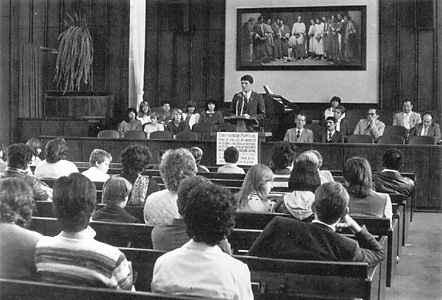
The Church in South America |
The Church in Northern South America
The Church in Southern South America
The first article discusses the establishment, growth, and development of the Church in Brazil. The second article covers the same points in Bolivia, Colombia, Ecuador, Peru, and Venezuela; and the third article covers Argentina, Chile, Paraguay, and Uruguay. After Parley P. Pratt, an apostle, his wife Phoebe Soper Pratt, and Elder Rufus C. Allen were unsuccessful in establishing a foothold in Valparaiso, Chile, in 1851-1852, it was not until 1925 that The Church of Jesus Christ of Latter-day Saints sent Melvin J. Ballard, another apostle; and Elders Rulon S. Wells, who spoke German, and Rey L. Pratt, who spoke Spanish, both of the Seventy, to open the South America Mission. Under assignment from President Heber J. Grant, these men dedicated the vast area of South America for the preaching of the gospel in Buenos Aires on December 25, 1925. The establishment of the Church in South America began in Argentina when some German LDS families emigrated there in the 1920s, and requested that missionaries and Church supplies be sent to Buenos Aires to help them build the Church among their families and friends. The Church moved into Brazil in 1928, also in answer to requests of LDS German emigrants living there. The first Latter-day Saints in Chile apparently were North American miners who worked in the mining district in northern Chile. The first missionaries were sent there from Argentina in 1956, and the Chilean Mission was established in 1961. The Church moved into Uruguay from Argentina in 1944, and into Paraguay from Uruguay in 1948. The first missionaries were sent to Peru from Uruguay in 1956.
Speaking at a Sacrament meeting in Buenos Aires in 1926, Elder Ballard likened the Church's potential in South America to a strong, mighty oak growing from a tiny acorn. He said there would be thousands of members and many missions growing from the tiny beginnings of the Church there, and South America would become one of the strongest areas of the Church. True to that prophecy, although the work went slowly for a number of years, with the location of a General Authority, Elder A. Theodore and Sister Marné Whittaker Tuttle, in South America in the 1960s to supervise missionary work, a dramatic surge of conversions began. The Church moved into the northern countries with the creation of the Andes Mission in Peru and Chile in 1959. The first units were established in Bolivia in 1964; in Ecuador in 1965; and in Colombia and Venezuela in 1966. Many of the LDS missionaries in South America are local members who have been strengthened and prepared for service and leadership by attending seminary and institute programs of the Church Educational System. Where the Church originally had only one mission in all of South America, in January 1991 it had 43 missions, 381 stakes and districts, and 3,791 wards and branches serving over 1.35 million members.]

A sacrament meeting in the Curitiba South Stake, Brazil, c. 1981.
by Flavia Garcia Erbolato
The LDS Church first came to Brazil in 1928, when several German converts emigrated to the German colonies in the southern states of Brazil and asked the Church for materials to teach their children. The Church grew slowly in Brazil until the 1960s and 1970s, when great numbers of Brazilians began joining. The first mission was divided to make new missions, stakes were organized and then divided, and in 1985 Brazil became an area with a resident area presidency of General Authorities. In January 1991 Brazil had an LDS temple, an area presidency, 12 missions, more than 2,100 LDS missionaries (over half local Brazilians), 87 stakes and districts, and over 800 wards and branches serving 366,000 members of the Church.
When President Reinhold Stoof visited the German members in Brazil in 1928 as president of the South American Mission, he was impressed with the potential he saw for missionary work there. The first LDS missionaries assigned to Brazil spoke German rather than Portuguese and began their missionary labors in the German colonies at Joinville, Santa Catarina State, on September 12, 1928. The first converts were baptized on April 14, 1929. Although the work progressed slowly at first, by October 1931 Joinville had the first LDS meetinghouse chapel in South America. The first Relief Society was organized there in 1933 with twenty-four members.
In 1935 the Brazil Mission was divided from the South American Mission with only 143 members of the Church in the entire mission. President Rulon S. Howells began preparing Church materials in Portuguese and then assigned some of the missionaries to learn Portuguese so that they could work with the Brazilians and not just with the German immigrants. In 1938 the Brazilian government prohibited the use of the German language in public meetings and schools, which made Church activities very difficult for the German-speaking members. With the advent of World War II and the North American missionaries being called home, many of the local branches of the Church were closed. However, some units, such as the Campinas Branch, had developed sufficient local leadership to be able to keep the branch functioning throughout the war and to bring in new members.
With the return of the North American missionaries in 1945 and the calling of local Brazilians to serve missions, the Church began to grow more rapidly in Brazil. That growth was aided by the visit of Stephen L Richards, an apostle, who toured the mission in 1948, and of President David O. McKay in 1955. Lifting the members spiritually, and recognizing their strength, President McKay authorized the building of meetinghouses (chapels) in which the Saints could worship. With this manifestation of confidence by the President of the Church, the local members reached out to share the gospel with their friends and neighbors. They especially shared the Church youth auxiliary program, which attracted many converts and became the center of proselytizing for the mission. They also developed pageants and theatrical presentations that showed the Brazilians what blessings being a member of the Church brings.
Another important event in the History of the Church in Brazil was the organization of its first stake, the Sao Paulo Brazil Stake, on May 1, 1966, with Walter Spät as president. By mid-1990 that first stake had grown to fifty-six stakes and almost six hundred wards and branches, all presided over by local Brazilian priesthood bearers.
The most significant event in the History of the Church in Brazil was the construction of the Sao Paulo Temple in 1978. That brought all the blessings of the Church to the Brazilian and other South American Saints. Former Mission President Finn B. Paulsen was called as temple president, and his wife, Sara Broadbent Paulsen, as the temple matron. With a temple in Brazil, the Church organized the first missionary training center in South America at Sao Paulo in 1979.
One of the most effective missionary tools the members used to present the message of the Church was a theatrical presentation, "The Gate," written by Ana Glucia Ceciliato and presented to more than 20,000 people at the open house for the Sao Paulo Temple before it was dedicated. To make the presentation required some sixty talented Church children, youth, and adults to travel many miles from several cities to Sao Paulo for rehearsals. The introduction of the Church seminary and institute programs also greatly strengthened the youth of the Church in Brazil.
The first translation of the Book of Mormon into Portuguese was printed in 1940. Some of the missionary tracts were translated and published a year earlier. The Portuguese translation of the Doctrine and Covenants was published in 1950, and the Pearl of Great Price in 1952, making all the latter-day scriptures available in the language of the people. The Church magazine for Portuguese-speaking members, A Gaivota (now A Liahona), began publication in 1948. Other Church materials are translated into Portuguese in Brazil for all Portuguese-speaking countries. The work of Elder William Grant and Sister Geri Hamblin Bangerter and of Elder James E. and Sister Ruth Wright Faust greatly expanded the Church in Brazil.
Two native Brazilians have been called as General Authorities of the Church. Hélio da Rocha Camargo, born in Rezende, Rio de Janeiro, on February 1, 1926, became a Seventy on April 7, 1985. A former Protestant minister, he was baptized a member of the Church on June 1, 1957. He was released from the Seventy in October 1990 and called as the president of the Sao Paulo Temple. Helvécio Martins, born in Rio de Janeiro on June 27, 1930, and baptized on July 2, 1972, was called to the Seventy on March 31, 1990. He is the first General Authority of African lineage.
Illustrations
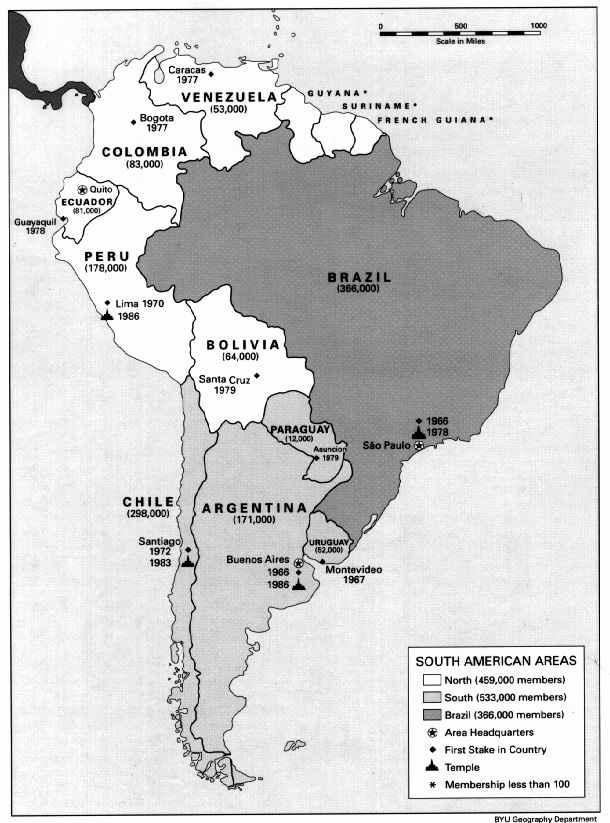
The Church of Jesus Christ of Latter-day Saints in South America as of January 1, 1991.
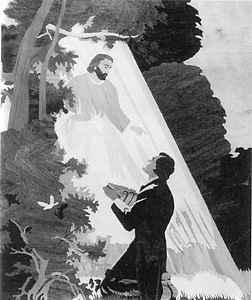
Joseph Receives the Plates, by Max Rezler (1973, Brazil, inlaid wood, 24" x 21"). This work by LDS Brazilian artist Max Rezlerl portrays the occasion when the Angel Moroni, on September 22, 1827, delivered to Joseph Smith the plates containing the Book of Mormon record. Church Museum of History and Art.
Bibliography
Grover, Mark L. "Mormonism in Brazil: Religion and Dependency in Latin America." Ph.D. diss., Indiana University, 1985.
Labarca, Ana Rosa. "Dias inesquecíveis de 1978—Uma nova era para a Igreja no Brasil." A Liahona 41 (Oct. 1988):4-5.
Williams, Frederick S., and Frederick G. Williams. From Acorn to Oak Tree: A Personal History of the Establishment and First Quarter Century Development of the South American Missions. Fullerton, Calif., 1987.
The Church in Northern South America
by Julio E. D Vila
BOLIVIA. The Church became legally established in Bolivia in 1963 through the work of North American LDS families living in La Paz and in Cochabamba. The first Bolivian was baptized and the first branch organized in 1964. The Bolivian Mission was organized in 1968, with headquarters in La Paz. Some of the first families who joined the Church are still active in leadership roles.
The first Bolivian stake was organized in January 1979 in Santa Cruz de la Sierra, with Noriharu Ishigaki Haraguichi as president. In March of the same year, the La Paz Stake was established, with Jorge Leano as president. In January 1991, he was serving as president of the Colombia Cali Mission.
Church materials going to Bolivia are printed in the three principal languages of the country: Spanish, Quechua, and Aymara. The LDS Bolivian youth, strengthened by the seminary and institute programs, have responded enthusiastically to the call to share the restored gospel; they currently make up 70 percent of the missionaries serving in the country. As a result of the dedicated missionary effort, approximately 64,000 members of the Church lived in Bolivia in January 1991. The Church enjoys the respect and admiration of the citizens and of government authorities because of the members' stability, spiritual contribution, and exemplary lifestyle. The construction of one hundred meetinghouses between 1987 and 1990, has given the members places in which to worship, as well as work opportunities to many Bolivians. The meetinghouses are also used as classrooms wherein the Bolivians are given the advantage of religious education and literacy training.
COLOMBIA. On March 20, 1966, the first branch of the Church was organized in Bogot, Colombia, with Harold M. Rex as president. When the government officials signed the record of the proceedings, The Church of Jesus Christ of Latter-day Saints was established in Colombia. Elder Spencer W. Kimball rededicated the country to the preaching of the gospel in Bogot on May 11, 1966. Colombia was part of the Andes Mission until 1968, when it became part of the Colombia-Venezuela Mission. The Colombia Bogot Mission began operations on July 1, 1971. That mission was divided in 1975, creating the Colombia Cali Mission. On July 1, 1988, a third mission, the Colombia Barranquilla Mission, was established.
The first chapel built in Colombia was built at Cali in 1975, in a section of the city where the Versalles Ward is located. The First Presidency has announced plans for the construction of a temple in Bogot .
The first stake in Colombia was organized at Bogot on January 23, 1977, by Elder Bruce R. McConkie, of the Quorum of the Twelve Apostles, with Julio E. D vila as president. On April 6, 1991, President D vila became the first native Colombian called to be a General Authority. In January 1991 there were nine stakes in the country: Bogot, Kennedy, Ciudad Jardín, El Dorado, Cali, Américas, Medellín, Bucaramanga, and Barranquilla. The progress of the Church in Colombia is noteworthy. More than 83,000 members are enjoying the benefits of the spiritual and temporal programs offered by the quorums of the priesthood, the auxiliary organizations, and the religious educational courses, as well as literacy classes in seminaries and institutes.
The feeling of unity has grown strong among Church members in Colombia, as was shown during the 1983 earthquake in the city of Popayán, in the southern part of the country. The Colombian Saints united to help provide the necessities of life as well as housing for the thousands injured and made homeless by the quake.
The March 1977 area conference with President Spencer W. Kimball was of great significance to the people of Colombia, as were the regional conferences of 1987 and 1989 with Elder Russell M. Ballard, of the Quorum of the Twelve Apostles, presiding.
ECUADOR. On April 27, 1964, Sterling Nicolaysen, president of the Andes Mission, was instructed by Elder A. Theodore Tuttle to register the "Corporation of the Church" in Ecuador. On Saturday, October 9, 1965, Elder Spencer W. Kimball, then of the Council of the Twelve Apostles, dedicated the land of Ecuador to the preaching of the restored gospel, offering the dedicatory prayer from the top of Panecillo Hill in Quito. In June 1969, the Ecuador Quito Mission was organized, with Louis Latimer as president. In January 1991 there were two missions in Ecuador, headquartered in Quito and Guayaquil.
The first nine members in Quito were baptized on October 31, 1965. Missionary work began in Guayaquil on January 20, 1966. Napoleón Trujillo, the first local missionary called from Ecuador, served in Uruguay. His father, José G. Trujillo, was serving as the patriarch of the Quito Stake in 1991.
Church materials for Ecuador are prepared in Spanish and Quechua, its two official languages. In 1978 Amado Ruíz, a member from Otavalo, translated some the materials needed by the Otavalo Indians, who received their own stake on December 6, 1981, with Luis Alfonzo Morales C. as president. Having Church materials in their native language has been a great help to the indigenous peoples who inhabit the diverse regions of the country.
Elder Mark E. Petersen, of the Quorum of the Twelve Apostles, organized the first stake in Guayaquil on June 11, 1978, and called Lorenzo Garaycoa as president. The first stake in Quito was organized on August 22, 1979, by Elder Gordon B. Hinckley, then of the Quorum of the Twelve, with Ernesto Franco as president.
The Church Educational System has performed an important role in the religious education of the Ecuadorian youth in seminaries and institutes and has made great strides in the area of literacy, especially among the indigenous Indian peoples. The many youths of Ecuador who serve as missionaries among their countrymen have brought the missionary work of the Church to all corners of their country. As of January 1991, the Church had 81,000 members served by two missions, 18 stakes and districts, and 121 wards and branches in Ecuador.
The First Presidency of the Church has announced plans to construct a temple in Guayaquil, Ecuador.
PERU. The first LDS contact with the people of Peru was in 1926, when Elder Melvin J. Ballard, returning to the United States after dedicating South America to the preaching of the gospel, visited Peru and was impressed that it would be a good place to send missionaries. Although several members lived in Peru in the 1940s and possibly even earlier, it was not until July 8, 1956, that Elder Henry D. Moyle, of the Quorum of the Twelve, and Frank K. Parry, president of the Uruguayan Mission, organized the first branch in Lima. Frederick S. Williams, former president of the South American and Uruguay missions, was called to be president of the branch, which began in his home. On November 1, 1959, Elder Harold B. Lee, then of the Quorum of the Twelve Apostles, organized the Andes Mission, which included Peru and Chile, and later Bolivia, Ecuador, Colombia, and Venezuela. Headquarters were in Lima. Two years later Peru had twelve branches of the Church and more than a thousand members.
Selected passages of the Book of Mormon and other Church materials have been translated into the Quechua and Aymara languages to help the new indigenous members gain a better understanding of the gospel.
The Lima Peru Stake was organized on February 22, 1970, with Roberto Vidal as president. It had six wards, three branches, and approximately 5,000 members. In January 1991 there were 5 missions, 57 stakes and districts, and over 500 wards and branches serving the 178,000 members of the Church in Peru. At the April 1989 multiregional conference held in Lima, more than 10,000 Latter-day Saints from nine of Lima's eighteen stakes attended. The Lima Peru Temple was dedicated by President Gordon B. Hinckley, First Counselor in the First Presidency, on January 10, 1986, with Samuel and Clara Lorenzi Boren as the first president and matron. In 1990 the Lima Temple operated with an average of nine Endowment sessions a day.
The Church is received with respect and enthusiasm throughout the country, where an ever-increasing number of local missionaries carry the message of the restored gospel to their people. Much credit for this success among the youth has been given to the significant role played by the Church members' religious education. More than 12,500 young Peruvians between the ages of fourteen and thirty have benefited from the courses available in the Church Educational System's seminaries and institutes. Sixty percent of the members of the Church in Peru are under thirty years of age.
VENEZUELA. On November 2, 1966, on special assignment from President David O. McKay, Elder Marion G. Romney, of the Quorum of the Twelve, dedicated the land of Venezuela for the preaching of the restored gospel. Present at that dedication was Elder F. Burton Howard, who was responsible for the legal registration of the Church in Venezuela, and Ted E. Brewerton, president of the Central American Mission (to which Venezuela belonged). Both men were later called to the Seventy.
From 1966 to 1968 there were only a few LDS missionaries in Venezuela, and progress was slow. From July 1968 to 1971, Venezuela formed a part of the Colombia-Venezuela Mission, but in 1971 the Venezuela Caracas Mission was organized, and the Church began a new era of growth. In 1978 the Venezuela Maracaibo Mission was divided from the Venezuela Caracas Mission, and President Alejandro Portal Campos, who had been the president of the Caracas Mission and the first Venezuelan to preside over a mission, was assigned the new mission.
The Caracas Stake, the first in Venezuela, was organized on May 15, 1977, under the direction of Elder Bruce R. McConkie; Adolfo Mayer was the president. In January 1991 there were seven stakes in Venezuela: two in Caracas, two in Maracaibo, and one each in Valencia, Oriente, and Guayana. There were also nine districts in the two missions. More than fifty thousand members of the Church in Venezuela have benefited from Church influence and have contributed significantly to the quality of life in their country. Because of the leadership training and skills that Church members receive and develop, many businesses and industries prefer to hire members of the Church. The Church seminary and institute programs have made significant contributions to the Venezuelan LDS youth. The influence that daily scripture study has had in their lives has made them want to participate in missionary work.
Bibliography
Cowan, Richard O. "The Church in Latin America." In The International Church, ed. James R. Moss et al., pp. 157-91. Provo, Utah, 1982.
Williams, Frederick S., and Frederick G. Williams. From Acorn to Oak Tree: A Personal History of the Establishment and First Quarter Century Development of the South American Missions. Fullerton, Calif., 1987.
anslated from Spanish by Lyman Sidney Shreeve and Afton Kartchner Shreeve.)
The Church in Southern South America
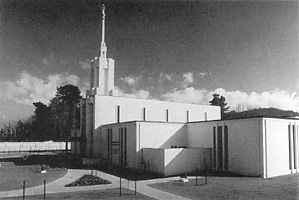
Santiago Chile Temple, dedicated 1983.
by Tom S F. Lindheimer
ARGENTINA. The Church was brought into Argentina by a few German immigrant families who had joined it in their homeland before they emigrated. They felt they needed to await the visit of Elder Melvin J. Ballard before they could baptize even their family members who wished to join. The first non-German convert was baptized in 1926. For several years the missionaries spoke only English and German, but emphasis was later placed on teaching also in Spanish, and that brought limited success to the Church's missionary work. The Church grew slowly in Argentina until the 1960s, when the emphasis was placed on training local member leadership. Mission President C. Laird Snelgrove organized a mission council in which he trained most of the men who would become the leaders during the next twenty-five years. A member of that council, Juan Carlos Avila, became the first native Argentine to be called as a mission president (1974-1977). The first Argentine stake was organized on November 20, 1966, presided over by a local priesthood bearer, Angel Abrea, who in 1976 would become the first Latin American General Authority. The mission was first divided in 1962, and by January 1991 the Church had nine missions, 64 stakes and districts, and over 500 wards and branches serving Argentina's 171,000 Latter-day Saints. The Buenos Aires Temple was dedicated on January 17, 1986, by Thomas S. Monson, Second Counselor in the First Presidency. Angel and Maria Victoria Chiapparino Abrea were the president and the matron. Argentina received a missionary training center in Buenos Aires, established in 1986 under President Lyman Sidney and Sister Afton Kartchner Shreeve, who had served missions in Argentina and presided over the Uruguay Mission.
CHILE. After Parley P. Pratt's unsuccessful attempt to establish a Church foothold in Chile in 1851-1852, the Church did not officially come to Chile until Brother William Fotheringham moved to Santiago, Chile, in 1952, and requested that the Church send missionaries there. The first regular missionaries arrived in Santiago just two weeks before Elder Henry D. Moyle, then of the Quorum of the Twelve Apostles, called Brother Fotheringham as the president of the first Chilean branch on July 5, 1956. It was made up primarily of expatriate members, the first local Chilean convert being baptized that same year.
The first mission in Chile was organized on October 8, 1961, with A. Delbert Palmer presiding. That single mission has grown to become six missions, with more than 50 percent of the missionaries called from the local members, many of whom have been prepared in large measure by their seminary and institute training. They are generally called to attend the Missionary Training Center in Santiago, the second such center in South America. The Church has grown rapidly in Chile, with almost 298,000 members on March 31, 1990. On January 1991, Carlos Cifuentes, one of those local converts, became the first native Chilean branch president and stake president. On September 15, 1983, the Santiago Chile Temple was dedicated. Eugene F. and Rae Stephens Jones Olsen were the president and matron. On March 31, 1990, Elder Eduardo Ayala, a former mission president in Uruguay, became the first native Chilean called to be a Seventy.
PARAGUAY. Even though in 1939 President Frederick S. Williams of the Argentine Mission traveled to the upper Pilcomayo River and visited Indian tribes there, as well as the people in Asunción, it was not until 1948 that the Church baptized its first Paraguayan convert. The Church was officially established when missionaries were sent to Paraguay from the Uruguay Mission in October 1949. Since the first baptism, Church growth has been steady. The Paraguay Mission was created in 1977, and the first stake was organized in Asunción on February 25, 1979, with Carlos R. Espinola as president. In 1980, the Church established an active branch made up of Indian converts from the Churupi-Nivacle tribe, in Mistolar village, about 800 kilometers northwest of Asunción.
URUGUAY. The first member of the Church to gain attention in Uruguay was Elder Rolf L. Larson, a missionary in the Argentina Mission who was named the most valuable basketball player in South America during the championship games held at Montevideo in January 1940. The first branch in Uruguay was organized with twelve members on June 25, 1944; the mission was organized on August 30, 1947, with the first converts being baptized on November 1, 1948. In the 1960s President and A. Sister Theodore Tuttle moved the headquarters of the South American Mission to Montevideo, which then became the center for the development of the Church throughout South America. The headquarters were later moved to Buenos Aries. The Montevideo Uruguay Stake was organized on November 12, 1967, with Vicente C. Rubio as president. Although the first plans for a temple in South America called for it to be built in Uruguay, it was eventually built in Sao Paulo, Brazil, in 1978. On January 1991, the Church had one mission, 18 stakes and districts, and 111 wards and branches serving over 50,000 Uruguayan Latter-day Saints.
Illustrations
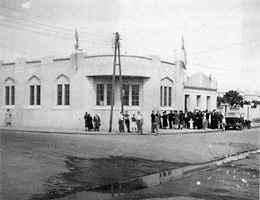
Liniers chapel in Liniers, Argentina, the first constructed in South America by the Church, at the time of its dedication on April 9, 1939. Courtesy Frederick G. Williams, III.
Bibliography
Cowan, Richard O. "The Church in Latin America." In The International Church, ed. James R. Moss et al., pp. 157-91. Provo, Utah, 1982.
Tullis, F. LaMond, ed. Mormonism: A Faith for All Cultures. Provo, Utah, 1978.
Williams, Frederick S., and Frederick G. Williams. From Acorn to Oak Tree: A Personal History of the Establishment and First Quarter Century Development of the South American Missions. Fullerton, Calif., 1987.
(See Basic Beliefs home page; Church Organization and Priesthood Authority home page; The Worldwide Church home page)
Encyclopedia of Mormonism, Vol. 1, South America, The Church in
Copyright © 1992 by Macmillan Publishing Company
All About Mormons |